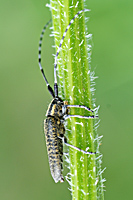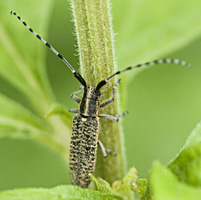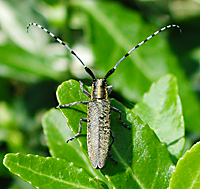[All pictures of garden wildlife on this page are thumbnails. Click on any thumbnail for a large format to be displayed.]

Golden-bloomed Grey Longhorn Beetle (Agapanthia villosoviridescens)
| Taxonomy | ||||||
|---|---|---|---|---|---|---|
| Kingdom: | Phylum: | Class: | Order: | Family: | Genus: | Species: |
| Animalia | Arthropoda | Insecta | Coleoptera | Cerambycidae | Agapanthia | A.villosoviridescens |
There are many members in the Longhorn Beetle family count over 15,000 species all over the world. In Western Europa alone at least 100 species have been identified. Longhorn Beetles usually distinguish themselves with strikingly long horns. Of course, there are some exceptions. Many species have beautiful colourful patterns and they all have a relatively slender body. A few Longhorn species are considered very harmful. Their larvae eat dead wood and live inside wooden parts of buildings and constructions. And because you can't actually see the insects, just the traces of little holes like the woodworm does, and because they can live as larvae for some 5 to 7 years, it's difficult to recognise the infestation. Once you spot the adults it is usually too late to rescue the wooden parts of your house or furniture. Most species however are not that disastrous because they live in stems of plants or reet. Agapanthia villosoviridescens is one of the harmless Longhorn Beetles and it spends its larval stage in stems of thistles.
Agapanthia villosoviridescens is an attractive species measuring 12 to 15 mm. Identification is easy: long antennae showing grey rings, a black body, covered in ochrous or greyish hairs. A line of hairs runs over the neckshield, ending near a small plume of hairs at the beginning of the back shields. Females bite a little wound in the stem of the host plant and deposite one egg in it. The larva eats its way towards the center of the stem and starts feeding, usually going downwards. It may even eat the roots of the plant. Then it makes a chamber and pupates inside. Host plants include thistles, Hogweed and Monk's Head. Adults appear from April to the end of August, and may be spotted to the end of October. A rather common species in the South of England. Not reported from Wales, Scotland and Ireland. A common species over most of Western Europe.

© Copyright 1998-2024 gardensafari.net (Hania Berdys)

 English / engels
English / engels  Dutch / nederlands
Dutch / nederlands





